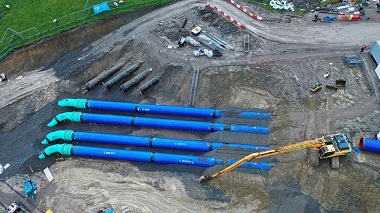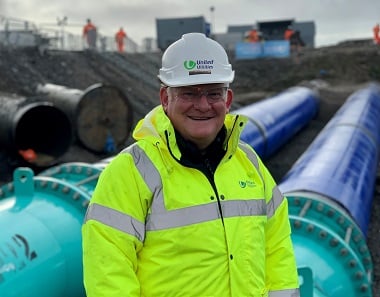Region’s biggest plumbing job done on time, in a storm, despite COVID

Aerial view shows the north connection pipework complete

John Hilton, United Utilities Project Director, at the site of the pipe connection
A crack team of 180 specialist engineers have pulled off the biggest plumbing job in the North West near Kendal despite severe storms and the effects of the COVID pandemic.
United Utilities connected four new 1.6m diameter pipes into the Haweswater Aqueduct – the large pipe supplying water in the North West - in under eight days.
Connecting the brand new section near Hallbank meant shutting down the aqueduct for the shortest period possible and marked its first major repair in the 65 years since it was built.
Project Director John Hilton said every hour of every day had been planned in meticulous detail to make sure it went smoothly.
“This is only the third time in its life that the aqueduct has ever been drained and I’ve been there every time. You’d think it would get easier but it doesn’t. This time we were working during a pandemic and we had biblical rain like you wouldn’t believe. When you’re planning something on this scale it’s right to be sensibly paranoid,” he said.
After nearly two years constructing the new 2.5km section of pipe, United Utilities handed the entire site to framework contractor Mott Macdonald Bentley to complete the connections. At its peak 90 engineers on round-the-clock socially-distanced shifts were working at either end.
The site was handed back to United Utilities early, after just seven days 22 hours and 46 minutes.
In the final hours, storms were so fierce that large steel huts erected to shelter welding activities were left in place to provide weather protection for the remaining work.
“The other big issue we faced was COVID. As well as rigorous round-the-clock cleaning, team distancing and testing, almost 100 extra trained staff had to be put on stand-by in case an entire work team had to self-isolate. We had hot and cold food brought in and we took over two hotels- one for the night shift, one for the day shift, to reduce the risk of contamination,” said John.
A dedicated team of cleaners worked 24 hours at each end of the pipe constantly disinfecting equipment and work areas earning them the nickname ‘COVID cops’ by site staff.
Project sponsor Martin Padley said it was hats off to everyone working on site for a job well done: “Despite the weather, this is the best time of year because there’s plenty of water available from other sources,” he explained.
“The main thing is that we have safeguarded a major essential piece of our regional water network for future generations and none of our customers were any the wiser. It takes careful planning, and round the clock vigilance by our teams across the region, to keep everyone’s taps flowing.
“United Utilities has a world class reputation for this kind of high intensity work. We shut the entire pipeline for two weeks in 2013 for its first ever complete inspection. After detailed analysis, and a further inspection in 2016, engineers identified several places where they needed to do some maintenance. This section at Hallbank is the first one.”
No time was wasted. While the pipeline was out of operation, another team of engineers took the opportunity to enter the Haweswater Aqueduct further south to carry out more inspection work.
The impressive feat of engineering completed at Hallbank is the first milestone in a much bigger project which will see the replacement of six more tunnel sections along the 109km Haweswater Aqueduct which supplies drinking water to 2.5 million customers in Cumbria, Lancashire and Greater Manchester. Plans for the Haweswater Aqueduct Resilience Programme are still in development with work on this mammoth £1bn pipe refurbishment project proposed to begin in 2023.
Fast facts: Haweswater Aqueduct:
• Commissioned by Manchester Corporation, a precursor to United Utilities
• More than 20 years in construction
• Powered by gravity, there are no pumps
• First water arrived in Manchester in 1955
• 109km long and made up of pipes and tunnels
• Can deliver up to 570 million litres of drinking water a day
• Supplies around 2.5 million customers in Cumbria, Lancashire and Greater Manchester.
The work at Hallbank in numbers:
• The first major upgrade on the HA for 65 years
• At 2.5km, the new section of pipe, is slightly longer than the piece it is replacing
• One pipe is being replaced by four separate pipes laid in parallel
• Each one of the four new pipes is made up of 200 pieces of 14m long in 1.6 diameter pipeline sections
• To maintain the flow of water by gravity, the new pipes have had to take a slightly different route to the original
• Having four pipes instead of one makes things easier for when we need to do maintenance like this in the future. We can take one pipe out of operation temporarily while the others keep supplying water
• The time taken to connect the new pipe was 7 days, 22 hours and 46 minutes
• More than three quarters of a mile (1.35km) of welds for the connections alone